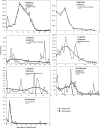Comparative genetic structure and demographic history in endemic galapagos weevils
- PMID: 22174444
- PMCID: PMC3283505
- DOI: 10.1093/jhered/esr124
Comparative genetic structure and demographic history in endemic galapagos weevils
Abstract
The challenge of maintaining genetic diversity within populations can be exacerbated for island endemics if they display population dynamics and behavioral attributes that expose them to genetic drift without the benefits of gene flow. We assess patterns of the genetic structure and demographic history in 27 populations of 9 species of flightless endemic Galápagos weevils from 9 of the islands and 1 winged introduced close relative. Analysis of mitochondrial DNA reveals a significant population structure and moderately variable, though demographically stable, populations for lowland endemics (F(ST) = 0.094-0.541; π: 0.014-0.042; Mismatch P = 0.003-0.026; and D((Tajima)) = -0.601 to 1.203), in contrast to signals of past contractions and expansions in highland specialists on 2 islands (Mismatch P = 0.003-0.026 and D((Tajima)) = -0.601 to 1.203). We interpret this series of variable and highly structured population groups as a system of long-established, independently founded island units, where structuring could be a signal of microallopatric differentiation due to patchy host plant distribution and poor dispersal abilities. We suggest that the severe reduction and subsequent increase of a suitably moist habitat that accompanied past climatic variation could have contributed to the observed population fluctuations in highland specialists. We propose the future exploration of hybridization between the introduced and highland endemic species on Santa Cruz, especially given the expansion of the introduced species into the highlands, the sensitivity to past climatic variation detected in highland populations, and the potentially threatened state of single-island endemics.
Figures



References
-
- Agudo R, Rico C, Hiraldo F, Donazar JA. Evidence of connectivity between continental and differentiated insular populations in a highly mobile species. Divers Distrib. 2011;17:1–12.
-
- Ayres DR, Grotkopp E, Zaremba K, Sloop CM, Blum MJ, Bailey JP, Anttila CK, Strong DR. Hybridization between invasive Spartina densiflora (Poaceae) and native S. foliosa in San Francisco Bay, California, USA. Am J Bot. 2008;95:713–719. - PubMed
-
- Balmer O, Ciofi C, Galbraith DA, Swingland IR, Zug GR, Caccone A. Population genetic structure of Aldabra giant tortoises. J Hered. 2011;102:29–37. - PubMed
-
- Beheregaray LB, Ciofi C, Geist D, Gibbs JP, Caccone A, Powell JR. Genes record a prehistoric volcano eruption in the Galápagos. Science. 2003;302:75. - PubMed
Publication types
MeSH terms
Substances
Grants and funding
LinkOut - more resources
Full Text Sources
Other Literature Sources
Research Materials
Miscellaneous

